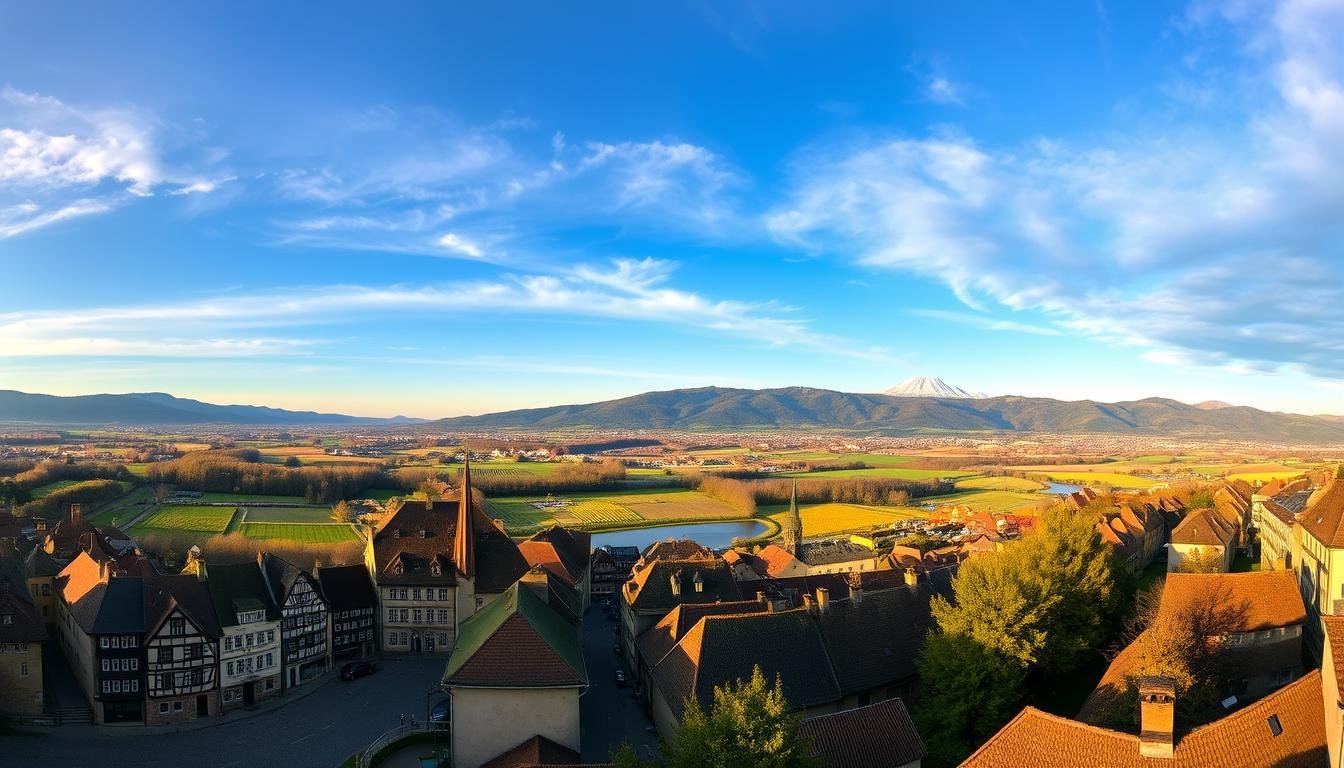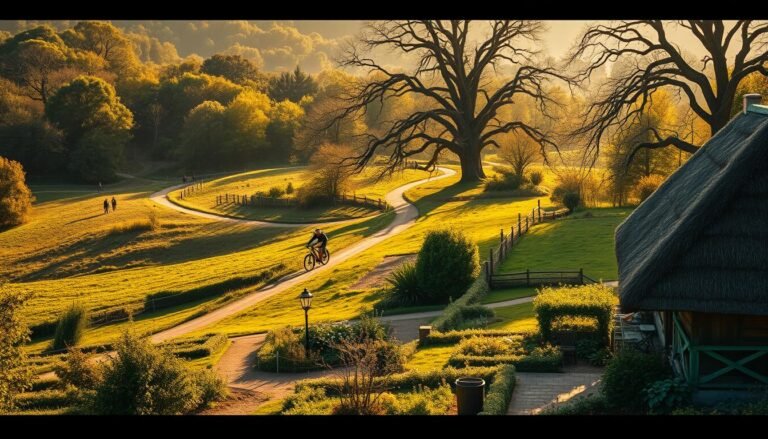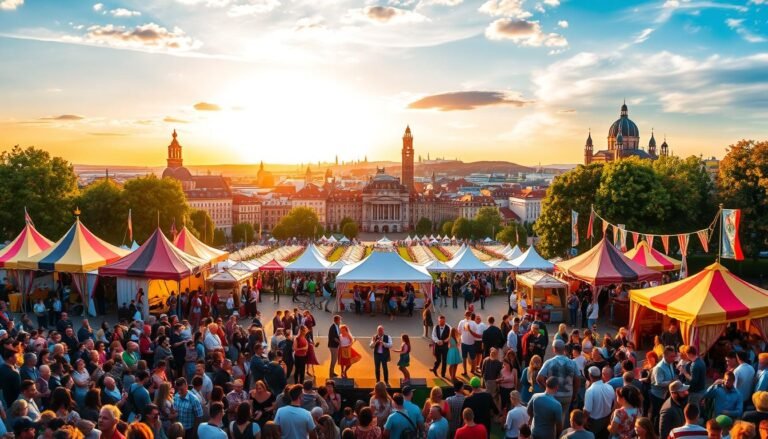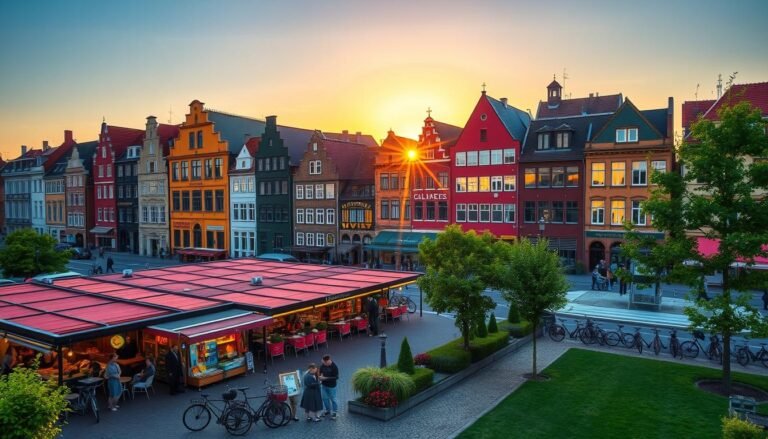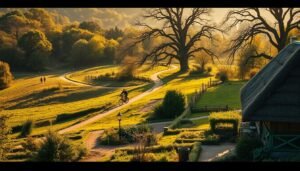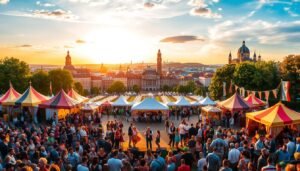Imagine Germany’s real magic is nowhere near famous spots. After a decade of exploring, I found something important. 2025 is the year to change your European travel plans.
Last winter, I enjoyed mulled wine with a glassblower in a Bavarian hamlet. At the same time, Munich’s squares were crowded. This spring, I explored Saxon Switzerland’s cliffs alone. These moments show a big change in travel.
The future of travel in Germany isn’t just about avoiding crowds. It’s about timeless villages and sustainable tourism. Places like the Moselle Valley and Bamberg offer more than just UNESCO sites. Why 2025? Global events and upgrades are steering tourism to places that help local communities.
Key Takeaways
- 2025 brings new rail routes and festivals to Germany’s overlooked regions
- Off-season travel reveals crowd-free access to cultural treasures
- Sustainable tourism projects are thriving in rural areas
- Historic cities beyond Berlin offer richer storytelling opportunities
- Local-led experiences provide authentic connections with traditions
Table of Contents
ToggleWhy Germany’s Hidden Gems Deserve Your Attention in 2025
Chasing crowded landmarks might take away from your German adventure’s soul. Last spring, I spent 45 minutes at Cologne Cathedral just to get one photo. But my favorite memory was sipping homemade schnapps with a woodcarver in Clausthal-Zellerfeld. This shows why 2025 needs a new way to travel in Germany.
Shifting Travel Trends in Post-Pandemic Europe
German National Tourist Board data shows a 63% rise in “undiscovered Germany” searches. Travelers want transformative experiences that mass tourism can’t offer. I’ve seen three big changes:
- More people prefer multi-day hikes over city tours
- There’s a growing interest in artisan workshops, like beer brewing in Bamberg
- 73% of Americans now look for eco-certified places to stay
| Pre-Pandemic | 2025 Forecast |
|---|---|
| Major cities only | Regional itineraries |
| Chain hotels | Family-run gasthofs |
| Souvenir shopping | Skill-building vacations |
How Underrated Destinations Enhance Cultural Immersion
Switching from Berlin to Quedlinburg was magical. Shopkeepers shared stories of medieval guild signs. A retired teacher showed me her attic and trachten (traditional dresses). These moments create lasting connections you can’t find in crowded places.
My Personal Approach to Sustainable Germany Travel
I’ve learned a sustainability checklist that works:
- Take regional trains instead of renting cars (DB’s €49 monthly pass is great)
- Book through platforms like Green Pearls® for eco-friendly places
- Eat at gasthäuser that serve farm-to-table food
In the Harz Mountains, I helped harvest for dinner at a bio-hotel. It lowered my carbon footprint and deepened my understanding of German food. Traveling with purpose is powerful.
Germany Travel 2025: 7 Unexpected Regions to Explore
Most travelers visit Munich’s beer halls or the Rhine’s castles. But I found quieter spots where cobblestone alleys tell old stories. These seven regions offer exploring Germany through sustainable adventures and living traditions. Let’s explore my top three favorites.
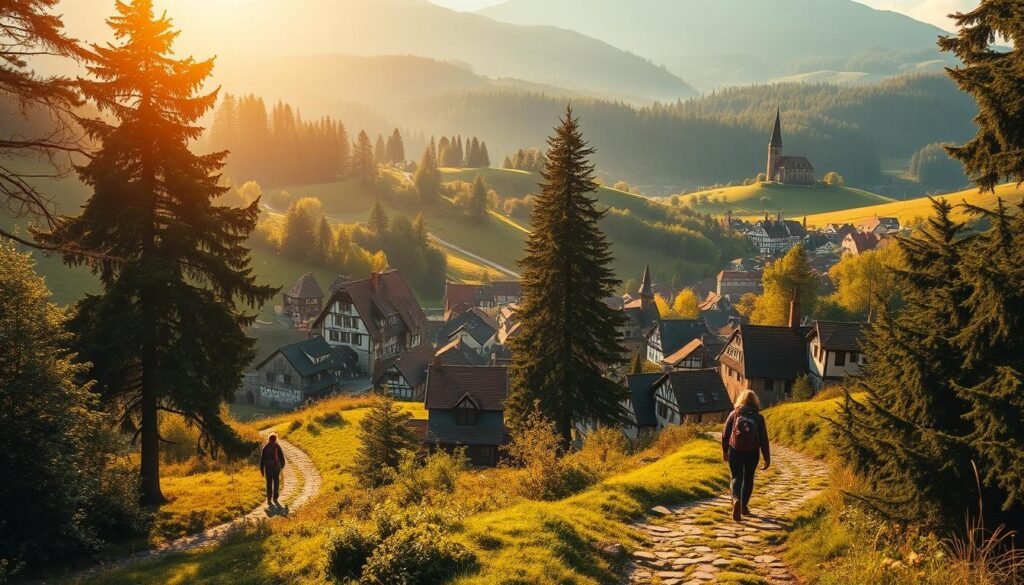
1. Harz Mountains: Medieval Towns & Sustainable Hiking
Last autumn, I followed a 14th-century salt trader’s route in Germany’s northernmost low mountain range. The Harz region shows eco-conscious travel can keep medieval charm alive.
How to Get There: Berlin to Wernigerode
Take the RE1 train from Berlin Hauptbahnhof (2.5 hours). Book the Harz-Berlin-Ticket for unlimited regional transport, including buses to trailheads.
Must-See: The Brocken Railway Experience
This steam-powered narrow-gauge railway climbs 3,428 feet through spruce forests. Time your ride for mid-week mornings when mist clings to the tracks – pure storybook atmosphere.
Local Tip: Overnight in a Fachwerkhaus Inn
I dream about the plum cake at Zum Wilden Mann, a half-timbered guesthouse in Quedlinburg. Their €99 “Historic Stay” package includes:
- Guided town walk at dusk
- Traditional Harzer cheese tasting
- Vintage map reproduction to keep
2. Bamberg’s Secret Beer Culture Beyond Rauchbier
Yes, the smoky classic draws crowds, but my favorite discovery sits beneath Klosterbräu brewery. It’s a 1248AD cellar where monks stored ice from the Regnitz River. Ask for “Eiskeller” at the taproom.
Navigating the 11 Historic Breweries
Use this table to prioritize your tastings:
| Brewery | Specialty | Best Experience |
|---|---|---|
| Schlenkerla | Aecht Schlenkerla Rauchbier | Morning tour (fewer crowds) |
| Greifenklau | Ungespundetes Lager | Beer garden sunset views |
| Ambräusianum | Brew-Your-Own workshops | Thursday fermentation classes |
Seasonal Festivals Most Tourists Miss
Mark your calendar for Bamberg Zwiebelmarkt (Onion Market) each September. Locals serve beer-steamed onions on rye bread – sounds odd, tastes divine.
3. Saxon Switzerland National Park: Rock Formations & Eco-Lodges
Forget the Instagram mobs at Bastei Bridge. Start your hike at Kurort Rathen Süd trailhead instead. Within 20 minutes, you’ll have Elbe Valley vistas without jostling for space.
Best Multi-Day Hiking Routes for 2025
The new 45-mile Malerweg Loop connects four eco-lodges. My favorite stop: Lichtenhainer Wasserfall’s cliffside cabins, bookable only through the park’s website until March.
Photography Tips for Bastei Bridge
Arrive by 6:15 AM in summer. The golden light hits the sandstone pillars while most visitors are en route. Use a circular polarizer to cut haze from the Elbe River below.
Coastal Hidden Gems: Baltic Sea Alternatives
Forget the crowded Mediterranean—Germany’s Baltic coast offers untapped adventures for 2025 travelers. While most visitors chase Rhine River views or Bavarian castles, I found windswept beaches and maritime secrets. These redefine coastal charm. Here’s where to find them.
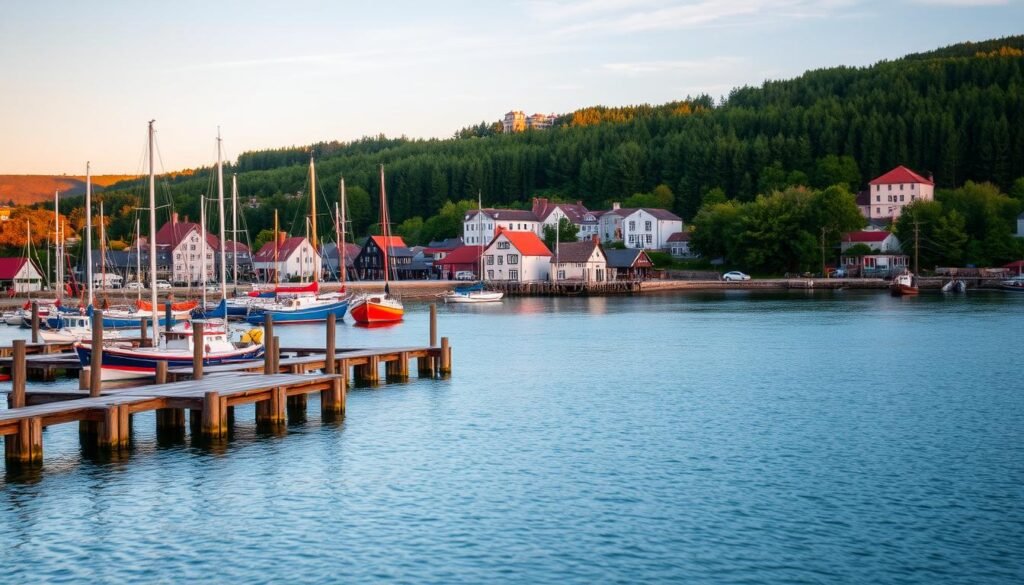
Lübeck’s Maritime History Beyond the Holstentor
Lübeck’s iconic red-brick gate is just the start. I spent days exploring its UNESCO-listed salt warehouses and chatting with sailors at the European Hansemuseum. But the real magic? Storm watching.
Timing Your Visit: Storm Watching Season
November-February brings drama to the coast. Locals taught me to track “Sturmflut” (storm surge) forecasts. My favorite spot? The rotating platform at Travemünde’s Maritim Hotel—hot cocoa in hand, waves crashing below.
| Month | Wave Height | Local Tip |
|---|---|---|
| November | 3-5m | Sunset storms = best photos |
| January | 4-6m | Weekday visits avoid crowds |
| February | 5-7m | Pair with warm Marzipan latte |
Local Specialty: Marzipan Tasting Trails
Niederegger’s shop displays marzipan sculptures worth flying for. But my kitchen disaster? Trying to recreate their 1570 recipe. “Almonds should be bitter?” I learned the hard way. Stick to their guided tasting menu—the rose petal variety changed my dessert game.
Usedom Island: Germany’s Sunrise Coast Secret
This 30-mile sandbar between Germany and Poland surprised me most. Cycle dune-backed paths at dawn, then breakfast on smoked fish from beachside shacks. Pro tip from a Heringsdorf fisherman:
“Cross to Świnoujście by ferry—Polish złoty buys pierogi feasts!”
Combining German/Polish Culture in One Trip
Usedom’s split geography means double the fun. Morning: German spa rituals at Ahlbeck’s art nouveau baths. Afternoon: Polish vodka tastings in seaside cottages. My border-hopping hack? The Usedom WelcomeCard covers transport in both countries.
| Activity | German Side | Polish Side |
|---|---|---|
| Cycling Routes | 10 themed trails | Wilderness paths |
| Local Dish | Fischbrötchen | Bigos stew |
| Architecture | Victorian villas | Communist-era mosaics |
Underrated Urban Explorations
While many visit Berlin’s graffiti and Munich’s beer halls, Germany’s smaller cities have their own wonders. Here, concrete meets creativity, perfect for those seeking authenticity without the crowds.
Chemnitz: Bauhaus Architecture & Industrial Chic
Chemnitz is a city where concrete buildings seem to dance in the sunlight. It’s different from Dresden’s Baroque domes 50 miles east. The city celebrates modernism, and my favorite spot is the Smac Museum.
Here, ancient artifacts shine against the exposed ductwork. It’s a unique sight.
2025 Modernism Anniversary Events
Plan your visit for the 100 Years of Bauhaus Influence celebrations. Here are some highlights:
| Event | Dates | Location |
|---|---|---|
| Concrete Poetry Festival | March 15-23 | Kunstsammlungen Museum |
| Night of Industrial Lights | June 7 | Former Textile Factory Complex |
| Modernism Architecture Walk | Weekly every Saturday | Starts at Karl Marx Monument |
Don’t miss the rooftop views at Hotel Chemnitzer Hof. Their 2025 renovation combines 1920s charm with modern solar ceilings.
Görlitz: Hollywood of Eastern Germany
I stumbled upon movie magic in Görlitz. I found a street that became Wes Anderson’s The Grand Budapest Hotel lobby. Over 100 films were filmed here, including The Book Thief.
Walking Tour of Movie Locations
Local guides share secrets every Thursday. Ask for the courtyard access code at Stadtapotheke pharmacy. It opens six private Renaissance courtyards.
- Best photo spot: Schönhof’s spiral staircase (featured in Inglourious Basterds)
- Hidden café: Café ViaThea serves “Camera Roll” pastries shaped like film reels
- Unexpected souvenir: Vintage prop replicas at Kleinmarkt 3
Görlitz shows that every cobblestone has played a role – sometimes many!
Germany’s Forgotten Wine Country
While many travel to France’s Bordeaux or Italy’s Tuscany, Germany’s vineyards are a hidden gem. I found hills where old traditions meet new sustainable practices. Here, your wine glass tells a tale older than many New World countries.
Saale-Unstrut Region: Vineyard Cycling Routes
Cycling through Saale-Unstrut’s hills taught me a few things. Always check your bike gears, and sparkling wine tastes better after a climb. This region has over 40 miles of cycling paths through UNESCO-protected areas. Local winemakers like Weingut Pawis use organic methods to protect the Saale River.
2025 Wine Festival Calendar
- April 19-21: Winzerfest Freyburg (sparkling wine tastings)
- June 7-9: Rotkäppchen Sekt Marathon (run through vineyards)
- September 13-15: Weinherbst Naumburg (harvest celebrations)
Moselle Valley’s Quiet Alternatives to Cochem
For authentic Moselle experiences, avoid the crowds with these tips:
- Find wineries with “Familienbetrieb seit…” (family-run) signs
- Look for small production sizes to support family operations
- Explore Weinwanderwege (wine hiking trails) in villages like Bremm
Family-Run Winery Stays
At Weingut St. Antony, I helped bottle Riesling with Klaus Jost, a fifth-generation owner. These stays offer:
- Vineyard-to-table dinners with local ingredients
- Stays in converted wine cellars
- Exclusive access to small-batch wines
“When you taste our wine, you’re drinking three centuries of soil wisdom.”
Planning Your 2025 Germany Adventure
Planning your 2025 Germany trip needs a mix of planning and being open to surprises. After 18 months of exploring, I’ve found a way to save money while enjoying real experiences. Let me share my tips to save you time.
Transportation Hacks for Regional Travel
Forget about pricey ICE trains. The real future of travel is in regional networks. Here are my top three tips:
- Deutschland-Ticket: Get unlimited regional transport for €49/month (great for a week-long trip)
- DB Navigator App: Use the “Only local transport” filter to save 60% compared to long-distance trains
- FlixBus Secret: Try their “Green Routes” for just €9 to connect places like Quedlinburg to Erfurt
Last February, I went from Leipzig to Thuringia’s Christmas markets for €11 using regional passes. That’s a big savings over €59 for ICE tickets.
Seasonal Considerations Month-by-Month
| Month | Smart Choice | Pro Tip |
|---|---|---|
| February | Thuringia’s castle stays | €35/night heaters included |
| July | Usedom Island beaches | Warmer than Baltic coast |
| October | Saale-Unstrut vineyards | Harvest festivals > Munich crowds |
Budgeting for Underrated Destinations
Here are some 2025 averages for off-the-beaten-path places:
- Accommodation: Stay in boutique places for €45/night, not €110 in tourist areas
- Dining: Enjoy regional dishes for €12 at family-run gasthäuser
- Activities: Explore 60% of your trip on free hiking trails
“The €49 ticket changed everything – I now plan trips by regional network instead of cities.”
Pro tip: Visit Saxony’s smaller towns on travel 2025 Wednesdays for free museum entry.
Why These Spots Will Define German Tourism in 2025
Germany’s hidden gems are not just pretty—they’re setting the stage for travel’s future. I’ve talked to tourism leaders in Lübeck and Airbnb hosts in the Harz Mountains. They’re gearing up for 2025.
Coastal towns like Usedom Island are building elevated paths to fight sea level rise. This turns a problem into a unique experience for visitors. It fits perfectly with the trend of eco-friendly travel in 2025.
Social media is also playing a big role. Instagram’s algorithm loves “undiscovered” spots. I think Harz Mountain villages like Wernigerode will be all over Instagram soon. Places like Saxon Switzerland and Bamberg are already attracting photographers looking for something different.
These spots offer real experiences that people are craving. They’re tired of crowded places.
Local economies are changing too. The Saale-Unstrut wine region offers bike tours and carbon-neutral shuttles. Moselle Valley towns focus on smaller wineries to avoid too many tourists. Cities like Chemnitz and Görlitz are preserving Bauhaus landmarks and film-worthy streets.
My advice? Visit these places now. They offer a mix of culture and nature without the crowds. Whether you’re hiking in the Harz or tasting wine in Franconia, you’re part of something new. Pack light, stay curious, and let these hidden spots amaze you.

